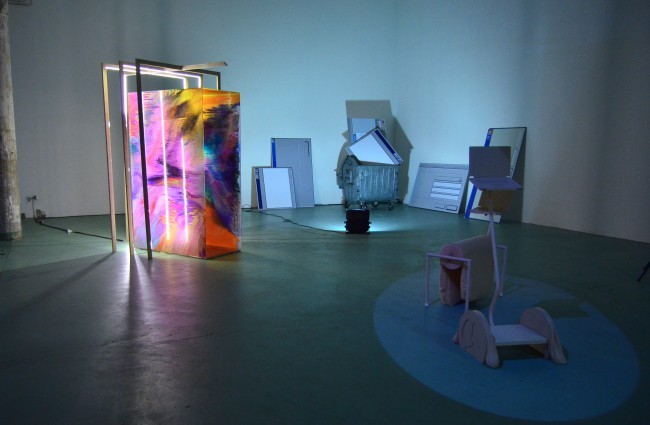Gym of Obsolete Technology
29 Jan - 28 Feb 2016
GYM OF OBSOLETE TECHNOLOGY
Amal Alhaag (NL), Michael Brennan (US), Femke Dekker (NL), Craig Fahner (CA), Maria Guggenbichler (DE), Steve Gurysh (US), Nikki Hock (NL), Annika Kappner (DE/NL), Willem Kempers (NL), Guz Konstantin (RU), Jan Robert Leegte (NL), Nicole Martens (NL), Margarita Osipian (CA/NL), Andrés Padilla Domene (MX/FR), Iván Puig (MX), Anna Reutinger (US), Luis Rodil-Fernández (SP), Helena Sanders (US/NL), Cas Spoelstra (NL)
29 January – 28 February 2016
When thousands of protesters took to the streets of Cairo to demand an end to the 30-year rule of President Hosni Mubarak, the Egyptian government cut the nation off from all forms of incoming and outgoing online communications. The breakdown, or disconnection, of wireless networks caused a rise in analogue communications and illuminated the physical structure of power and control that exists in what we often perceive to be ‘immaterial’ and decentralized communications channels.
The exhibition Gym of Obsolete Technology in W139 opens on the 29th of January and runs through until the 28th of February. During Gym of Obsolete Technology, artists visualize and give form to the tensions between the analogue and the digital that come into being during moments of transference, circumvention, and interference.
Imagine a space where visitors can pass iMacs back and forth like medicine balls. Where virtual reality experiences lead the brain while old hard drives train muscles during a fitness class. The ‘gym’ installation serves as the entrance point into the exhibition, where visitors can interact with the weight of obsolete technologies in a surreal gym framework.
With the original intention in mind, the participating artists of Gym of Obsolete Technology branch out to deal with topics such as economies of energy, our fantasies of physical interaction with the digital, the clumsiness of technology, use and obsolescence in our social experience of technology, digital materiality, how the sacred is transformed through digital simulation, and the visualization of invisible signals. The exhibition illuminates the increasingly invisible and ubiquitous digital form, while simultaneously pointing to the weight and waste generated by planned obsolescence and a tireless quest for ‘innovation’ and novelty in digital objects.
Amal Alhaag (NL), Michael Brennan (US), Femke Dekker (NL), Craig Fahner (CA), Maria Guggenbichler (DE), Steve Gurysh (US), Nikki Hock (NL), Annika Kappner (DE/NL), Willem Kempers (NL), Guz Konstantin (RU), Jan Robert Leegte (NL), Nicole Martens (NL), Margarita Osipian (CA/NL), Andrés Padilla Domene (MX/FR), Iván Puig (MX), Anna Reutinger (US), Luis Rodil-Fernández (SP), Helena Sanders (US/NL), Cas Spoelstra (NL)
29 January – 28 February 2016
When thousands of protesters took to the streets of Cairo to demand an end to the 30-year rule of President Hosni Mubarak, the Egyptian government cut the nation off from all forms of incoming and outgoing online communications. The breakdown, or disconnection, of wireless networks caused a rise in analogue communications and illuminated the physical structure of power and control that exists in what we often perceive to be ‘immaterial’ and decentralized communications channels.
The exhibition Gym of Obsolete Technology in W139 opens on the 29th of January and runs through until the 28th of February. During Gym of Obsolete Technology, artists visualize and give form to the tensions between the analogue and the digital that come into being during moments of transference, circumvention, and interference.
Imagine a space where visitors can pass iMacs back and forth like medicine balls. Where virtual reality experiences lead the brain while old hard drives train muscles during a fitness class. The ‘gym’ installation serves as the entrance point into the exhibition, where visitors can interact with the weight of obsolete technologies in a surreal gym framework.
With the original intention in mind, the participating artists of Gym of Obsolete Technology branch out to deal with topics such as economies of energy, our fantasies of physical interaction with the digital, the clumsiness of technology, use and obsolescence in our social experience of technology, digital materiality, how the sacred is transformed through digital simulation, and the visualization of invisible signals. The exhibition illuminates the increasingly invisible and ubiquitous digital form, while simultaneously pointing to the weight and waste generated by planned obsolescence and a tireless quest for ‘innovation’ and novelty in digital objects.

